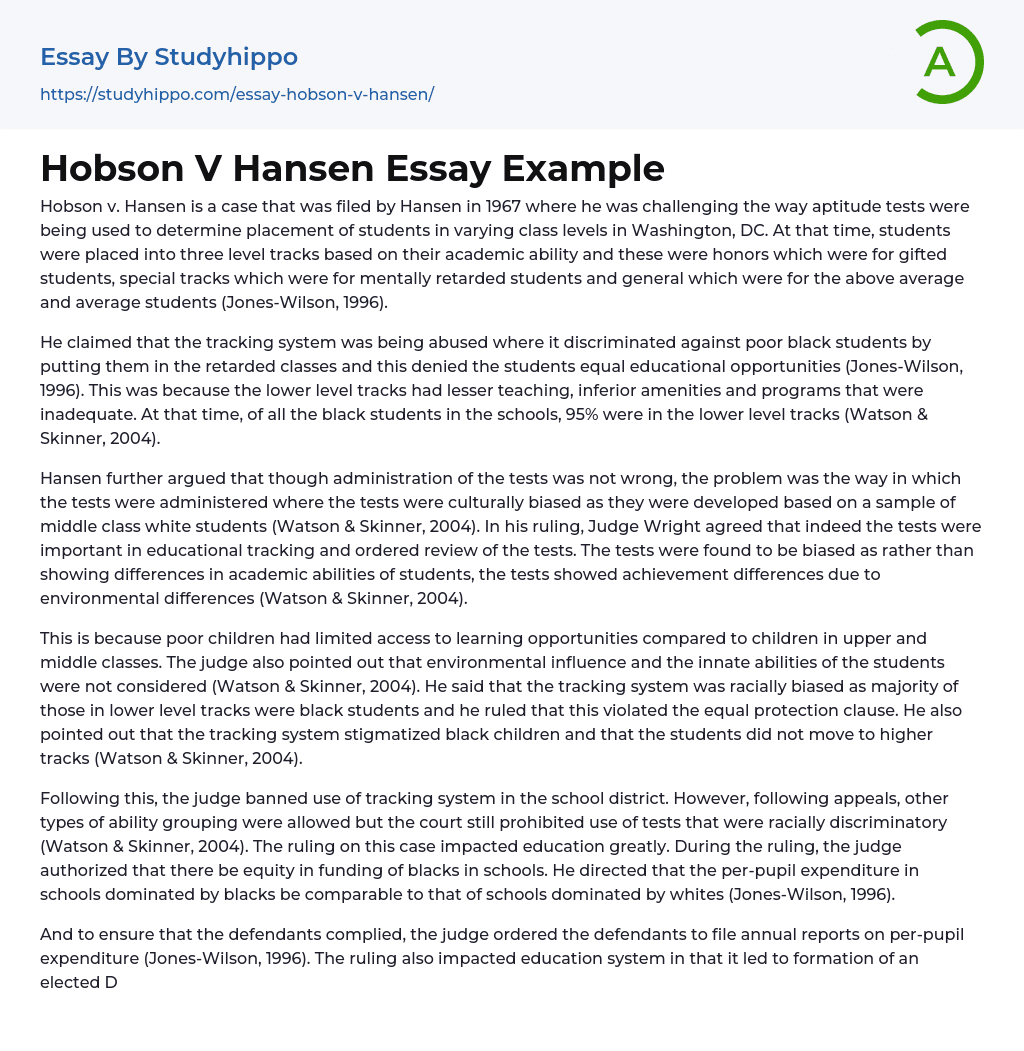Hobson v. Hansen is a case that was filed by Hansen in 1967 where he was challenging the way aptitude tests were being used to determine placement of students in varying class levels in Washington, DC. At that time, students were placed into three level tracks based on their academic ability and these were honors which were for gifted students, special tracks which were for mentally retarded students and general which were for the above average and average students (Jones-Wilson, 1996).
He claimed that the tracking system was being abused where it discriminated against poor black students by putting them in the retarded classes and this denied the students equal educational opportunities (Jones-Wilson, 1996). This was because the lower level tracks had lesser teaching, inferior amenities and programs that were inadequate. At that time, of a
...ll the black students in the schools, 95% were in the lower level tracks (Watson & Skinner, 2004).
Hansen further argued that though administration of the tests was not wrong, the problem was the way in which the tests were administered where the tests were culturally biased as they were developed based on a sample of middle class white students (Watson & Skinner, 2004). In his ruling, Judge Wright agreed that indeed the tests were important in educational tracking and ordered review of the tests. The tests were found to be biased as rather than showing differences in academic abilities of students, the tests showed achievement differences due to environmental differences (Watson & Skinner, 2004).
This is because poor children had limited access to learning opportunities compared to children in upper and middle classes. The
judge also pointed out that environmental influence and the innate abilities of the students were not considered (Watson & Skinner, 2004). He said that the tracking system was racially biased as majority of those in lower level tracks were black students and he ruled that this violated the equal protection clause. He also pointed out that the tracking system stigmatized black children and that the students did not move to higher tracks (Watson & Skinner, 2004).
Following this, the judge banned use of tracking system in the school district. However, following appeals, other types of ability grouping were allowed but the court still prohibited use of tests that were racially discriminatory (Watson & Skinner, 2004). The ruling on this case impacted education greatly. During the ruling, the judge authorized that there be equity in funding of blacks in schools. He directed that the per-pupil expenditure in schools dominated by blacks be comparable to that of schools dominated by whites (Jones-Wilson, 1996).
And to ensure that the defendants complied, the judge ordered the defendants to file annual reports on per-pupil expenditure (Jones-Wilson, 1996). The ruling also impacted education system in that it led to formation of an elected DC board of education which is operational to date and whose members are still elected (Jones-Wilson, 1996). The judge also abolished optional zones and directed that an assignment plan be developed for the pupils (Jones-Wilson, 1996). The ruling on this case impacted the job of school psychologists as they were required to develop new criteria to determine placement of students.
Judge Wright had recommended employment of tests that measured the innate ability of students. This
ruling made use of aptitude testing as the basis for placement less important (Watson & Skinner, 2004). The psychologists were now supposed to be careful about the tests they designed and administered as the tests were not supposed to be racially discriminative. No doubt that this case really impacted education system in the U. S. by stopping discrimination of African American students based on their racial and economic background.
- Academia essays
- Higher Education essays
- Language Learning essays
- Studying Business essays
- Education System essays
- Study essays
- First Day of School essays
- Scholarship essays
- Pedagogy essays
- Curriculum essays
- Coursework essays
- Studying Abroad essays
- Philosophy of Education essays
- Purpose of Education essays
- Brainstorming essays
- Educational Goals essays
- Importance Of College Education essays
- Brown V Board of Education essays
- The Importance Of Higher Education essays
- Online Education Vs Traditional Education essays
- Academic And Career Goals essays
- Academic Integrity essays
- Brown Vs Board Of Education essays
- Distance learning essays
- Technology in Education essays
- Vocabulary essays
- Writing Experience essays
- Importance of Education essays
- Early Childhood Education essays
- Academic Degree essays
- Academic Dishonesty essays
- School Uniform essays
- Academic writing essays
- Cheating essays
- Bachelor's Degree essays
- MBA essays
- College Life essays
- Grade essays
- Diploma essays
- Phonology essays
- Sentence essays
- Filipino Language essays
- Pragmatics essays
- Millennium Development Goals essays
- History Of Education essays
- Graduate School essays
- Middle School essays
- School essays
- Special Education essays
- University essays




